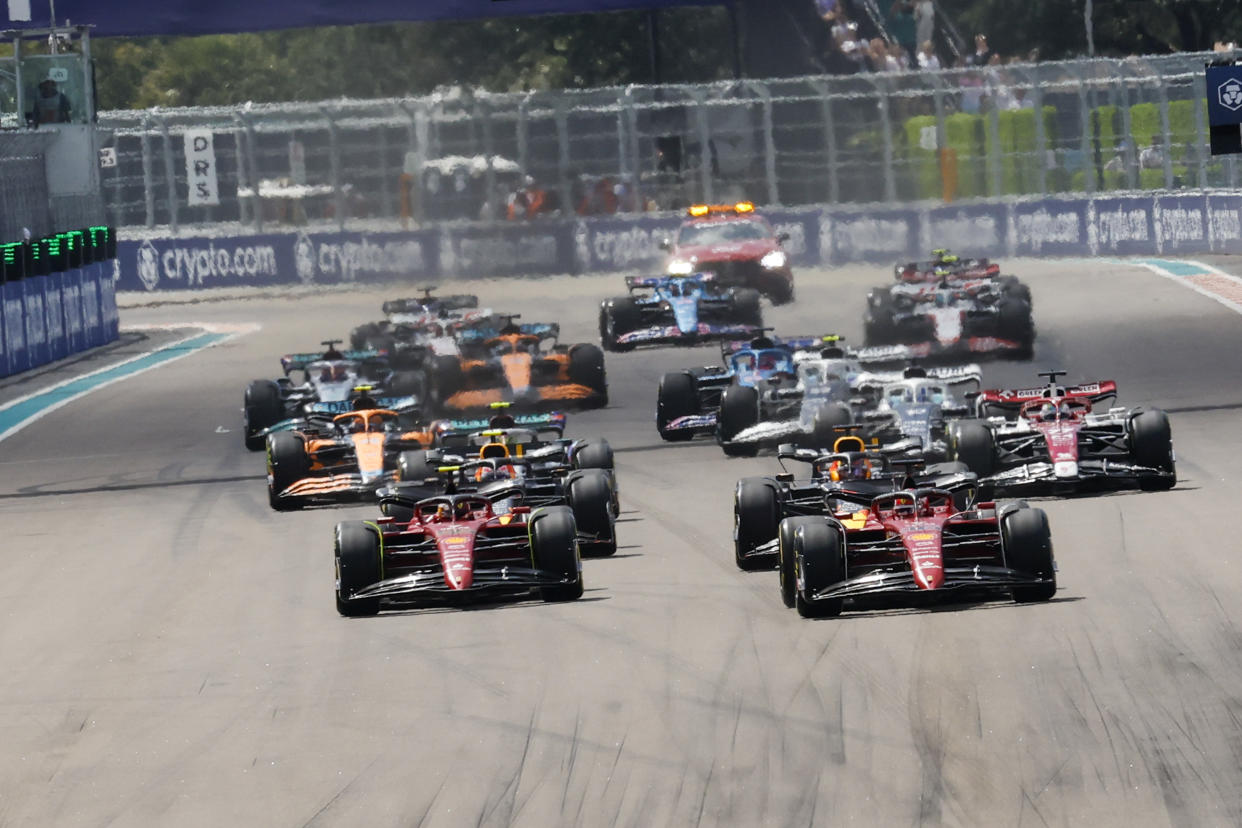F1 Miami Grand Prix scores more U.S. viewers 18-49 than NASCAR race at Darlington
More adults under the age of 50 watched Sunday’s Formula 1 Miami Grand Prix than the NASCAR Cup Series race at Darlington.
The Miami Grand Prix won by Max Verstappen was the second-most watched F1 race in U.S. history, with 2.07 million viewers for both the pre-race and race on ABC and ESPN. Over 700,000 of those viewers were in the coveted 18-49 demographic.
The Cup Series race at Darlington won by Joey Logano started at the same time on Fox Sports 1. NASCAR barely won the overall viewer battle with 2.6 million viewers but just 517,000 of those viewers were adults under the age of 50.
When the pre-race show is excluded from the F1 viewer numbers, the race audience jumps to 2.6 million and just short of the NASCAR raceaccording to ESPN.
The only Formula 1 race to score better ratings in the United States than the Miami Grand Prix was a tape-delayed broadcast of the 2002 Monaco Grand Prix. Sunday’s race was the first Formula 1 race in Miami and the first of two races in the United States this season. F1’s number of U.S. races will expand to three in 2023 with the addition of the Las Vegas Grand Prix.
F1’s new races in the U.S. come amid rapid viewer growth. ESPN’s networks averaged over 930,000 viewers for F1 races in 2021 after scoring an average audience of 608,000 viewers in 2020.
The Miami race was undoubtedly the biggest event in sports over the weekend as well. Celebrities like Michael Jordan, Tom Brady, Serena Williams, David Beckham and others were in attendance as F1 raced on a temporary circuit built around the Miami Dolphins’ Hard Rock Stadium.

The 'Drive to Survive' effect?
Much of Formula 1’s growth in the United States has been attributed to the popularity of Netflix’s “Drive to Survive.” The docuseries was recently renewed for two more seasons through 2024 as it rates as one of Netflix’s most popular original offerings. It’s hard to see F1 on such a trajectory without the series.
NASCAR, meanwhile, doesn’t have such a series. Its lone attempt at Netflix programming after “Drive to Survive” debuted was a short-lived sitcom with Kevin James that didn’t make it to a second season.
As Sunday showed, NASCAR is still king when it comes to overall viewers in the United States. The Cup race entered Sunday at an inherent viewer disadvantage because of the relatively small audiences that programming on Fox Sports 1 typically draws. And it still (barely) beat a Formula 1 race that aired on a broadcast network and one of the biggest cable networks.
But the TV numbers lay bare how much Formula 1 is making inroads with younger adults as NASCAR struggles to retain them.
Vast majority of NASCAR's audience is older
The roughly 80% of people outside of the 18-49 demographic who watched Sunday’s Cup Series race is consistent with viewership trends across the 2022 NASCAR season. Fewer than 2 million of the 8.7 million that watched the Daytona 500 were adults younger than 50 and just 830,000 of the 4.7 million who watched the April 24 race at Talladega were aged 18-49.
NASCAR’s overall TV viewership has stabilized in 2022 after years of declines from its peak in the 2000s. While TV numbers have stopped dropping, fewer adults under the age of 50 are watching the Cup Series.
Before February, the last regularly scheduled Daytona 500 was run in 2019. That race had 300,000 more viewers overall than the 2022 race. And 368,000 more adults under the age of 50 watched the 2019 race than did in 2022. The decline was bigger in that significant demographic than it was overall.
The April 24 race at Talladega on Fox had 30,000 fewer viewers than the same race in 2021. But just 830,000 of the 4.68 million who watched the race in 2022 were adults under 50 compared to 940,000 in 2021.
Formula 1, meanwhile, had 1 million viewers for its race at Imola that same morning on ESPN. And just over 500,000 of those viewers were adults in the 18-49 demographic, meaning that F1 scored just 330,000 fewer adults under 50 than NASCAR did despite NASCAR getting nearly five times as many total viewers.
We still don’t know if Formula 1’s quick growth in the United States is a bubble that could burst sometime soon or part of a longer-term trend. And we aren’t going to know for quite some time. But that growth is at least momentary proof that millennials and Gen Z will watch auto racing. Especially if there are compelling storylines attached.
NASCAR drivers keep getting younger
NASCAR has searched for that younger audience for years and those attempts have yet to pay off as its viewership trends older and older. It’s a glaring incongruence as drivers at the top levels have gotten younger thanks to family money, sponsor relationships and the cheaper salaries teams can pay them.
Those younger drivers are also not all that publicly interesting. “Drive to Survive” has hooked viewers of all ages by showing the personalities of drivers and the people who run the teams while NASCAR hasn’t had anything similar to endear viewers. Success wasn’t the only driver of the appeal of drivers like Dale Earnhardt, Jeff Gordon and Tony Stewart.
The racing in the Cup Series has been objectively better in 2022 thanks to the new car. But that racing also can’t solely be the appeal of the Cup Series. Younger fans especially need other compelling reasons to tune in for a three-hour race. NASCAR currently doesn’t have those easily marketable reasons. And until it does, it’s hard to see how F1 won’t keep making inroads among young adults as NASCAR doesn’t.
